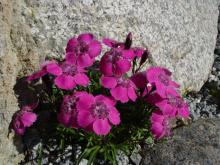Descriptions of sand beds seem to indicate pure coarse sand maybe 12 inches over native soil. An old formula for cold climate cactus suggested 1 part soil to 9 parts sand. Sand beds in our area often seem to allow roots to reach our clay topsoil--which feels inconsistent somehow.
I've heard recently about using mostly crushed trap rock in a bed. I'm wondering now about crushed limestone.
We had a hot, humid, but dry summer in New England USA. Cacti and Yucca didn't flinch, and Viola pedata would have looked good except for the rabbits; but I lost several Penstemons. For misc. other plants, I'm not sure if it was dryness or humidity that was the problem. (and/or spider mites?)
Right now I'm thinking about 9 parts coarse sand, 1 part small crushed marble, 1 part crusted trap rock (basalt?) and 1 part sandy compost. Just thinking that coarse quartz sand seems to be an extremely sterile medium. I have been using some liquid fertilizer in my sand bed.
Guess there is no one size fits all. Then there is the question of watering and when. Guess I don't expect any answers.
Will try to post my results from time to time.
Charles Swanson NE New England USA
Afterthought:
We have some beaches here with quartz sand with the consistency of table salt. No surprise that a beach pea grows; but there must be an explanation for the strong growth of a beach grass and Hudsonia.
Comments
Re: "Soil" mix question New England USA
Charles:
I have often wondered why alpines do so well in sand beds when, as you note, it seems such a sterile medium. The sand I use is not just coarse sand but has crushed rock included by the supplier. This is because it is used as a base course for paving stones and it compacts better with some fine crushed rock included. I have found it works better than just coarse sand in the rock garden and Ian Young may have hit on the reason in a recent bulb log at SRGC. Ian notes:
To replenish the nutrients I add some volcanic rock dust; a rich source of minerals and trace elements essential to the health of all plants. I have discussed the benefits of this volcanic rock dust, which is being marketed quite widely in Scotland, in the bulb log in previous years. The addition of rock dust to improve the fertility of soil has long been recognised as I have read in old journals that the quarry men took home rock dust to spread on their gardens and they had the best gardens.
I believe the crushed rock is providing the fertility despite the apparent sterility. Sand without rock dust will also have minerals but it will be less available to the plants.
For years I tried to grow Dianthus alpinus in the rock garden without success. Then when I tried a sand bed for the Dianthus they became extremely happy. Here is an example.


Dennis H., an outdoor cactus grower here in Minnesota uses trap rock too. I am not sure what it really is. Very dense(heavy) and angular, homogeneous gray. He mixes it with garden soil, so there is "just enough soil to fill the spaces between the rock."
He also grow greenhouse cactus and succulents, mostly from seed, and uses no sand there either. He uses Fafard 52 mix. Dennis spoke and conducted a workshop at our 2010 April meeting. I bought several of his non-hardy plants growing in the 52 mix and they are growing wonderfully.
The native cactus (three species) here in Minnesota do not necessarily grow in perfectly draining soils. But they are soils that dry rather quickly due to the small volume, usually in rock crevices or very shallow soils over rock.